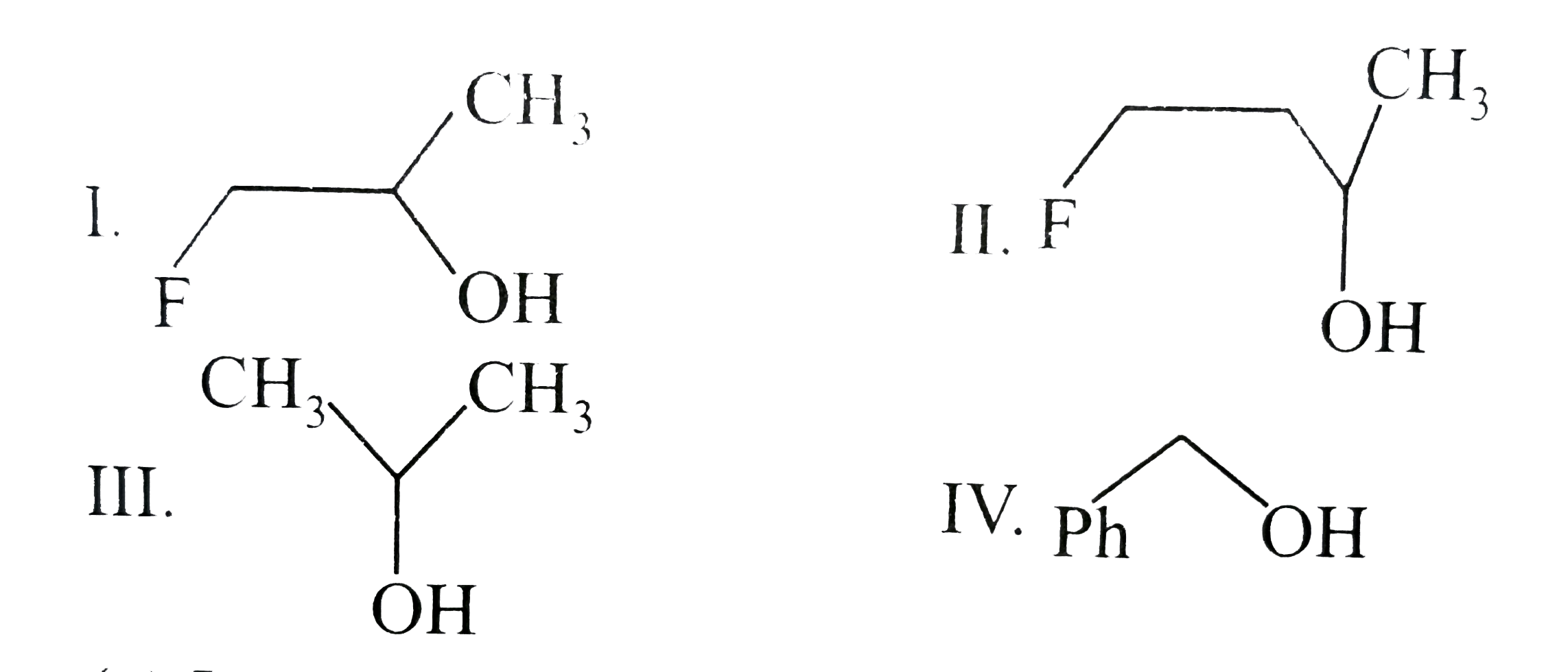Complete Solutions to Inductive, Resonance, Mesomeric And Hyperconjugation of chapter SOME BASIC PRINCIPALS OF ORGANIC CHEMISTRY of Class 11 book with complete answers and questions
| Class 11 | CHEMISTRY |
| Chapter | SOME BASIC PRINCIPALS OF ORGANIC CHEMISTRY |
| A2Z | Inductive, Resonance, Mesomeric And Hyperconjugation |
| Number Of Questions | 67 |
| Academic Year | 2023-24 |
Inductive effect involve
01:33View SolutionIf
 is mixed with `NaOH` solution, acid-base reaction occurs and snatches from organic molecule. Which carbon will lose easily? 02:18View Solution
is mixed with `NaOH` solution, acid-base reaction occurs and snatches from organic molecule. Which carbon will lose easily? 02:18View SolutionThe inductive effects of the group `-CH_(3),-COO^(-),-Br,-NH_(3)^(+)` respectively are
01:05View SolutionWhat is the correct increasing order of extent of deprotonation of the following acids in its aqueous solution?
(I) `(CH_3)_2CHCOOH`
(II) `CH_3CH_2COOH`
(III) `Cl_2CHCH_2COOH`
(IV) `CH_3C Cl_2COOH`02:45View SolutionSelect correct statement about `I` effect?
02:53View SolutionDecreasing `-I` effect of given is:
(i) `CN` , (ii) `NO_(2)`
(iii) `NH_(2)` , (iv) `F`02:05View SolutionWhich of the following group shows `+I` effects?
01:48View SolutionFind the strongest acid among the following compound
02:09View SolutionWhich of the following alkyl groups has the maximum `+I` effect?
01:45View SolutionWhich of the following is the strongest `-I` group?
01:18View SolutionIn which of the following species, incorrect direction of Inductive effect is shown?
02:40View SolutionThe order of reactivity of the following alcohols towards conc. `HCI` is
I. II.
II. 
III. IV.
IV.  03:31View Solution
03:31View Solution`(CH_(3))_(3)C CH_(2)COOH` is more acidic than `(CH_(3))_(3)SiCH_(2)COOH` because
02:13View SolutionFor the following acids
`underset((I))((CH_(3))_(3)C CH_(2)CO_(2)H) " " underset((II))((CH_(3))_(3)overset(o+)(N)CH_(2)CO_(2)H) " " underset((III))(CH_(3)COOH)`
`pK_(a)` value will be in order04:30View SolutionWhich of the following acids has the smallest dissociation constant?
04:34View SolutionAssign number `1` for least to `4` for most to indicate the relative base strength of the following
`{:(I,,II),(C_(6)H_(5)NH_(2),,p-NO_(2)C_(6)H_(4)NH_(2)),(III,,IV),(m-NO_(2)C_(6)H_(4)NH_(2),,p-CH_(3)OC_(6)H_(4)NH_(2)):}`04:12View Solution , `pK_(a)` value of the compound decreases if `X` is: 04:23View Solution
, `pK_(a)` value of the compound decreases if `X` is: 04:23View SolutionWhich of the following pairs are resonating structures ?
02:33View SolutionWhich is the incorrect statement regarding resonance contributing structures?
02:14View SolutionPolarization of electrons in acrolein may be written as:
01:09View SolutionThe bond order of individual carbon-carbon bond in benzene is
02:37View SolutionWhat is the decreasing order of acidic strength of the following compound for their most acidic hydrogen?
`CH_(3)-CHO(I),CH_(3)-NO_(2) (II),CH_(3)-CH=CH_(2) (III)`03:57View SolutionWhich is the most stable resonating structure?
01:31View SolutionResonance effect involves:
02:21View SolutionDuring delocalization, which statement is incorrect:
02:58View SolutionWhich of the following resonating structures of `1`-methoxy-`1`,`3`-butadiene is least stable?
02:29View Solution`KOH` can be used as drying agent for
01:06View SolutionWhich of the following statements is incorrect?
01:27View SolutionWhich of the following statements regarding resonance is `NOT` correct?
03:15View SolutionResonance energy is:
00:46View SolutionWhich of the following species cannot show resonance?
01:05View SolutionResonance is not possible in:
01:11View SolutionWhich does not have conjugate system?
01:03View SolutionThe compound which is not resonance stabilised
01:14View SolutionIn which of the following first resonating structure is more stable than the second?
02:15View SolutionThe correct stability order of the following resonance structure is:
`{:(CH_(2)=C=O,H_(2)overset(-)(C)-overset(+)(C)=O,H_(2)O=overset(+)(C)-overset(-)(O) , H_(2)overset(-)(C)-C-=O),((I),(II),(III),"(IV)"):}`01:41View SolutionWhich is the most stable resonating structure?
01:31View SolutionThe correct stability order of given resonating structures
 01:47View Solution
01:47View SolutionWhich of the following group shows `+m` effects?
02:10View SolutionWhich of the following group show `-m` effect?
02:27View SolutionWhich of the following group shown `+mgt - I` effect?
01:48View SolutionWhich of the following group show `-m` and `-I` effect?
01:35View SolutionIdentify which of the following group as `+M` as well as `-M`?
01:37View Solution`+m` and `+I` both effects are shown by:
01:49View SolutionThe weakest `+m` group of the given species by:
01:30View SolutionThe most unlikely representation of resonance structure of `p`-nitrophenoxide ion is:
01:53View SolutionIn which delocalisation of positive charge is possible?
04:01View SolutionResonance stabilized cation is:
02:42View SolutionWhich of the following is not the correct resonating structure of `C_(6)H_(5)NH_(2)`?
02:39View SolutionLeast contributing resonating structure of nitroethene is:
01:10View SolutionThe least and most stable resonating structures respectively are:
 03:42View Solution
03:42View SolutionWhich of the following species does not have equally contributing resonating structures?
03:04View SolutionThe correct order of electron density in aromatic ring of following compounds is:
 04:05View Solution
04:05View SolutionMost stable radical among the following is:
01:46View SolutionArrange the following radicals in decreasing order of their stability.
(I) `overset(*)(C)H_(3)`
(II) `CH_(3)-overset(*)(C )H_(2)`
(III) 03:14View Solution
03:14View SolutionThe hyperconjugative stabilities of tert-butyl cation and `2`-butane, respectively, are due to
03:47View SolutionArrange the following increasing order of number of hyperconjugation structures.
(I) `CH_(3)-overset(.)(C)H-CH_(3)`
(II) `CH_(3)-overset(CH_(3))overset(|)CH-overset(.)(C)H-CH_(3)`
(III) `CH_(3)-overset(CH_(3))overset(|)underset(.)C-CH_(3)`01:20View SolutionArrangements of `(CH_(3))_(3)C-,(CH_(3))_(2)CH-,CH_(3).CH_(2)-` when attached to benzyl or `n` unsaturated group in increasing order of inductive effects is:
02:11View SolutionHyperconjugation involves the overlapping of the following orbitals :
03:28View SolutionWhich of the following cannot exhibit hyperconjugation?
01:38View SolutionWhich of the following alkenes will show maximum number of hyperconjugation forms?
01:08View SolutionWhich one of the following has inductive, mesomeric and hyperconjugation effect?
02:19View SolutionIn which of the following `C=C` bond length is minimum?
02:33View SolutionWhich of the following is correct about the following compound
 03:30View Solution
03:30View SolutionIn which case the `sigma` bond pair and `pi` bond pair of electrons both are attracted in the same direction (towards same atom):
02:46View SolutionThe correct heat of hydrogenation order of
 01:39View Solution
01:39View SolutionThe minimum magnitude of heat of hydrogenation per mole of molecule is of:
02:34View Solution
Inductive, Resonance, Mesomeric And Hyperconjugation questions and complete solutions for chapter SOME BASIC PRINCIPALS OF ORGANIC CHEMISTRY of A2Z CHEMISTRY (HINGLISH) of Class 11
All Exercises from A2Z Class 11 CHEMISTRY SOME BASIC PRINCIPALS OF ORGANIC CHEMISTRY
- Acid And Basic Strength
- AIIMS Questions
- AIPMT/ NEET Questions
- Assertion- Reasoning Questions
- Bond Fission, Reagents, Reactive Intermediates And Their Stability
- Confirmational Isomerism
- Geometrical Isomerism
- Inductive, Resonance, Mesomeric And Hyperconjugation
- Optical Isomerism
- Section B - Assertion Reasoning
- Section D - Chapter End Test
- Structure Isomerism
- Tautomerism
